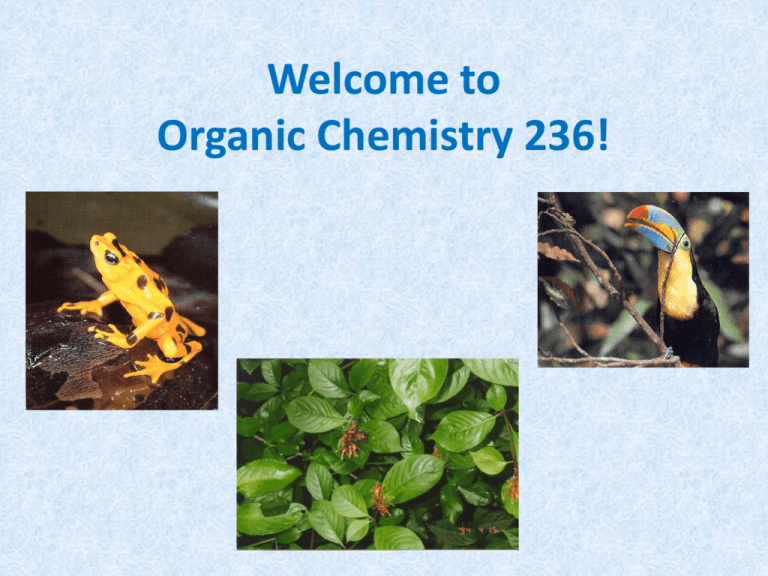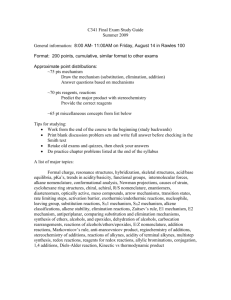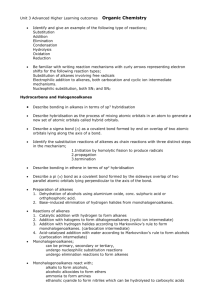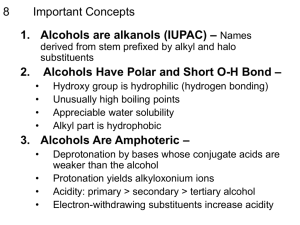Nucleophilic Substitution Reactions of Epoxides
advertisement

Welcome to Organic Chemistry 236! How Should I Study? • Do not memorize everything! • Practice writing mechanisms and “talking” yourself through the steps. • Learn to ask the right questions. • Form a small study group (2-3 people). • Work as many problems as you can. • Do not hesitate to visit me during office hours for assistance. • A free tutoring service is available through the LRC. Fall 2011 Dr. Halligan CHM 236 Chapter 10 • Reactions of Alcohols, Ethers, Epoxides, Amines, and Sulfur-Containing Compounds Ch. 10 Overview • • • • • Conversion of Alcohols to Alkyl Halides and Sulfonate Esters Substitution reactions of activated alcohols (ROH with better LG’s) Dehydration of alcohols via Elimination Reactions Oxidation of Alcohols Nucleophilic Substitution Reactions of Ethers • Nucleophilic Substitution Reactions of Epoxides • Amines Do Not Undergo Substitution or Elimination Reactions • Quaternary Ammonium Hydroxiudes Undergo Elimination Reactions • Phase-Transfer Catalysts • Thiols, Sulfides, and Sulfonium Salts Substitution Reactions of Alcohols • The OH group of an alcohol is a terrible LG. Why? • We must convert the OH group to a better LG before doing a substitution reaction. • In this chapter, we will use HCl, HBr, HI, ZnCl2, PBr2, SOCl2, and R’SO2Cl/py to convert OH to a better LG. OH + Br Br + OH strong base (you need a weak/stable base) Alcohols and ethers have to be activated before they can undergo a substitution or an elimination reaction: Convert the strongly basic leaving group (OH–) into the good leaving group, H2O (a weaker base): Only weakly basic nucleophiles can be used 6 Primary, secondary, and tertiary alcohols all undergo nucleophilic substitution reactions with HI, HBr, and HCl: 7 Secondary and tertiary alcohols undergo SN1 reactions with hydrogen halides: 8 Primary alcohols undergo SN2 reactions with hydrogen halides: Reaction carried out in 48% aqueous HBr. Recall that Br– is an excellent nucleophile in water. 9 ZnCl2 can be used to catalyze certain SN2 reactions: ZnCl2 functions as a Lewis acid that complexes strongly with the lonepair electrons on oxygen: 10 The Lucas Reagent Anhydrous ZnCl2 in conc HCl Distinguishes primary, secondary, and tertiary low-molecularweight alcohols The Lucas reaction: ZnCl2 ROH + HCl RCl Positive test: Solution becomes cloudy Test results and mechanisms at room temperature: SN 2 • Primary: No reaction SN2 and SN1 • Secondary: Reaction in ~5 minutes • Tertiary, allylic, and benzylic: Reaction immediate SN 1 11 Look out for rearrangement product in the SN1 reaction of the secondary or tertiary alcohol: 12 Other Methods for Converting Alcohols into Alkyl Halides Utilization of phosphorus tribromide: Other phosphorus reagents can be used: PBr3, phosphorus tribromide PCl3, phosphorus trichloride PCl5, phosphorus pentachloride POCl3, phosphorus oxychloride 13 Activation by SOCl2 Pyridine is generally used as a solvent and also acts as a base: 14 The Artificial Sweetener Splenda (Sucralose) Could Splenda be a cellular alkylating agent? No, it is too polar to enter a cell. 15 16 Summary: Converting of Alcohols to Alkyl Halides Recommended procedures: 17 Converting Alcohols into Sulfonate Esters 18 Several sulfonyl chlorides are available to activate OH groups: 19 Dehydration of Secondary and Tertiary Alcohols by an E1 Pathway To prevent the rehydration of the alkene product, one needs to remove the product as it is formed 20 The major product is the most stable alkene product: The most stable alkene product has the most stable transition state 21 The rate of dehydration reflects the ease with which the carbocation is formed: 22 Look out for carbocation rearrangement: 23 Complex Alcohol Rearrangements in Strong Acid 24 Pinacol Rearrangement Protonate alcohol: Eliminate water: Rearrange carbocation: Deprotonate: H3 C CH3 H 3C Resonance-stabilized oxocarbocation CH3 O 25 Ring Expansion and Contraction Show the mechanism for this reaction: •Protonate the alcohol. •Eliminate water. •Rearrange carbocation to afford the more stable cyclohexane ring. •Deprotonate. 26 Primary Alcohols Undergo Dehydration by an E2 Pathway 27 The Stereochemical Outcome of the E1 Dehydration Alcohols and ethers undergo SN1/E1 reactions unless they would have to form a primary carbocation 28 A Milder Way to Dehydrate an Alcohol 29 Oxidation by Chromium (VI) 30 Primary alcohols are oxidized to aldehydes and eventually carboxylic acids: Mechanism: 31 The oxidation of aldehydes to acids requires the presence of water: In the absence of water, the oxidation stops at the aldehyde: PCC, a methylene chloride–soluble reagent: No water present 32 A tertiary alcohol cannot be oxidized and is converted to a stable chromate ester instead: O O Cr O O No hydrogen on this carbon Di-tert-Butyl Chromate 33 Amines do not undergo substitution reactions because NH2– is a very strong base (a very poor leaving group): Protonation of the amine moiety does not solve the problem: 34 Nucleophilic Substitution Reactions of Ethers Ethers, like alcohols, can be activated by protonation: 35 Ether cleavage: an SN1 reaction: Ether cleavage: an SN2 reaction: 36 Reagents such as SOCl2 and PCl3 can activate alcohols but not ethers Ethers are frequently used as solvents because only they react with hydrogen halides 37 Nucleophilic Substitution Reactions of Epoxides Recall Section 4.9 38 Epoxides are more reactive than ethers in nucleophilic substitution reactions because of ring strain: 39 Acid-Catalyzed Epoxide Ring Opening Stereospecificity of epoxide ring opening: Reason: Back-side attack of water on protonated epoxide: A trans diol 40 Reaction of an epoxide in the presence of methanol and acid Regioselectivity: Mechanism: 41 When a nucleophile attacks an unprotonated epoxide, the reaction is a pure SN2 reaction: Therefore: 42 Epoxides Are Synthetically Useful Reagents Enantiomers 43 Epoxy resins are the strongest adhesives known: Amine nucleophile mediated epoxide ring opening: 44 Arene Oxides: Arene oxides are versatile compounds with interesting chemistries. They are compounds in which one of the “double bonds” of the aromatic ring has been converted into an epoxide. What happens to aromatic compounds when they enter the body as a foreign substance (such as cigarette smoke, drugs, charcoalbroiled meats or automobile exhaust)? 45 Arene Oxide Reactions • • • • • • Arene oxides participate in two types of reactions. They undergo nucleophilic attacks of the epoxide ring to form addition products (unlike regular epoxides). They can also undergo a rearrangement reaction to form a phenol. Whether or not a certain arene oxide is carcinogenic depends its subsequent reaction pathway (rearrangement or nucleophilic substitution). If it proceeds through the rearrangement pathway, non-carcinogenic phenols will be produced. However, if it undergoes nucleophilic attack by DNA, this can lead to carcinogenic products. Y OH Y addition product O OH rearranged product Mechanism for arene oxide rearrangement: 47 How Do Arene Oxides Cause Cancer? DNA backbone 48 BENZO[a]PYRENE EPOXIDATION Not all smokers get cancer Benzopyrenes in chimneys were responsible for cancer of the scrotum in “chimneyboys.” The connection between cancer and chimney soot was made by Percivall Pott in 1775. 49 Reactions of 4° Ammonium Hydroxides • A fully alkylated amino group (quaternary), makes a good enough LG for the “E2” Hofmann Elimination Reaction. • If the 4° amino group was protonated, the E2 base, would just deprotonate the 4° amino group and there would be no E2 reaction. Hofmann Elimination Favors anti-Zaitsev Products • Do you remember the 3 exceptions for E2 reactions in terms of predicting the major products? • Usually, the more substituted alkene is the major product except if there is a big bulky base, possibility of conjugation or a Fluorine LG. • Here, the quaternary ammonium salt is a relatively slow LG just like Fluorine. As the E2 base comes in to abstract the proton, a negative charge starts to build up on the B-carbon. Remember that carbanion stability is the opposite of carbocation stability. Crown Ethers The ability of a host to bond only certain guests is an example of molecular recognition 52 Crown Ether Reactions • Crown ethers serve as excellent phase-transfer catalysts for reactions. • The crown ether enables a reaction to be carried out in two phases (polar and nonpolar). • • This is exemplified in the reaction of 1-bromohexane with acetate ion. The acetate ion is only soluble in water whereas the 1-bromohexane is only soluble in nonpolar solvents. The crown ether helps dissolve the acetate by binding the inorganic ion species (e.g. Na+ or K+) in its cavity and then the whole crown-guest complex is soluble in the nonpolar solvent (benzene in this case). • Thiols are sulfur analogs of alcohols: Thiols form strong complexes with heavy metal cations Thiols are stronger acids (pKa = 10) than alcohols Thiols are not good at hydrogen bonding 54 Thiols, Sulfides, and Sulfonium Salts • Thiols are sulfur analogs of alcohols with SH replacing the OH of the alcohol. • Thiols are also known as mercaptans because they form stable heavy metal derivatives with species such as mercuric and arsenic ions. • Low MW thiols have strong and offensive odors, such as those present in onions, garlic and skunks. • The –SH group ranks just below an alcohol in terms of naming. In protic solvent, thiolate ions are better nucleophiles than alkoxide ions: Sulfur is an excellent nucleophile because its Electron cloud is polarized 56






